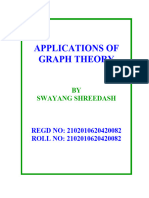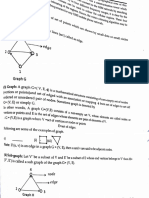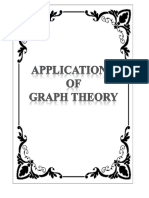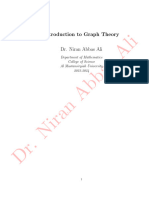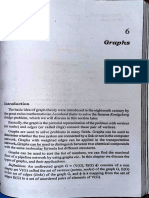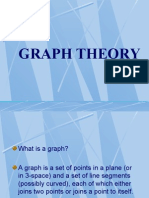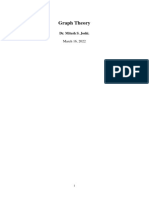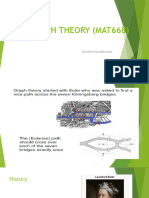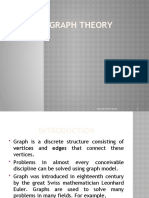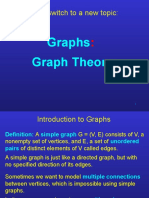0 ratings0% found this document useful (0 votes)
48 views44 pagesGraph Theory
Uploaded by
Abhishek SinghCopyright
© © All Rights Reserved
We take content rights seriously. If you suspect this is your content, claim it here.
Available Formats
Download as PDF or read online on Scribd
0 ratings0% found this document useful (0 votes)
48 views44 pagesGraph Theory
Uploaded by
Abhishek SinghCopyright
© © All Rights Reserved
We take content rights seriously. If you suspect this is your content, claim it here.
Available Formats
Download as PDF or read online on Scribd
You are on page 1/ 44
GRAPH THEORY
Art-1, Introduction
Graph theory was bor in 1736 with Euler’s paper in which he solved the
Konigsberg bridge problem. In 1947. G.R. Kirchoff developed the theory of trees for
their application in electrical network. A Caylay also discovered trees while he was
trying to enumerate the isomers of saturated hydrocarbon C,, Hy +2. They also lay down
four color conjective, which states that four colour are sufficient for colouring any atlas
such that the countries with comrign boundaries have different colour.
Now a day Graph Theory is employed in many areas, such as Communications,
Engineering, Physical Sciences, Social Sciences etc. On account of diversity of its
application, it is useful to develop and study the subject in abstract form and then import
its results. In general areas of computer science such as switching theory and logical
design artificial intelligence, formal languages, computer graphics, operating system,
graph theory is very useful.
In this chapter, we shall define the various components of the graph theory along
with suitable examples. An attempt has been made to show that graphs can be usefill to
represent any problem involving discrete arrangements of objects, where concem is not
with the internal properties of these objects but with the relationships along them.
Art-2.Terminology
(P.T.U. B.C.A.-I, 2006)
A graph (or undirected graph) is a diagram consisting of a collection of vertices
together with edges joining certain pair of these vertices. Mathematically, we can write
A graph G = [VG). EG)}
where V(G) and E (G) are sets defined as
V(G) = Vertex set (points set or nodes set) of the graph G,
E(G) c V(G) x V (G), a relation on V(G), called edge set of G
Each element e of E(G) is assigned on unordered pair of vertices (a, b) called the
end vertices of ¢.
Scanned with CamScanner
a
v
SPECTRUM DISCRETE STRUCTURES
‘A directed graph is a graph in which each element ¢ of E (G) is assigned.an
ordered pair of vertices (a, 6) along with arrow starting from a to bj'where a is called
the initial vertex and b is called the terminal vertex of the edge e.
(P.T.U. B.C.A-I, 2006)
‘The graphs directed and undirected are shown in the following figures :
(DIRECTED GRAPH) (UNDIRECTED GRAPH)
(OA graph is represented by means of a diagram in which the vertices are
denoted by points and edges are represented by line segments joining its,end vertices.
(ii) It does not matter whether the joining of the two vertices in a graph is a
straight line or a curve, longer or shorter.
Two vertices « and v of a graph G = (V, E) are said to be adjacent if there is an
edge e = (u, v) connecting u and v. Also the edge e is said to be incident on each of its
end points u and v.
For example :- In the above diagram a and b are adjacent vertices. Since there is an edge
e1 = (a, b) joining a and b. Also the vertices a and d are not adjacent, as there is no edge
joining the vertices a and d.
Loop (or self loop)
An edge that is incident from
* self loop or sting.
For Example :- In the above diay the is it ™
re ample zln gram the edge e7 is a loop. Since the edge e7 = (b, b)
_ Isolated Vertex
A vertex of a graph G = (V, E ich i woe . .
cilled an isolated venex, 1» WHieh snot joined to any vertex by an edge in Gs
For example :- In the above dia;
igtam the vertex x is an isolated vertex. |
Tf two (or more) edges of .
called parallel age 'Bes ofa graph G have the same end vertices,
For example :
edges.
and into itself starts and ends at same vertex is called
then these edges are
h ;
n the above diagram the edges ey = (c, 4.) and eg = (6, d’) are parallel
Scanned with CamScanner
GRAPH THEORY
Incidence
‘An edge e of a graph G = (V, E) is said to be incident with the vertex v if v is an
end vertex of e (or w incident with e)
Two non-parallel edges of the graph are called adjacent if they have one common
vertex.
For example :- In the above diagram the edges ¢; = (a, b) and e, = (a, c) are adjacent
vertices, as they have a common end vertex a.
“Art-3. Types of Graphs
(@ Simple graph :
A graph which has neither loop nor parallel edge is called simple graph.
a
a d
es es
e es
& 7
b
& f 5 e c
The above graphs are simple graphs.
(General graphi(or Multi graph) (P.TU. Bwc.A-I, 2004)
A graph which have either loop or parallel edge or both, is called a general graph or
(P.T.U. B.C.A.-I, 2004)
a multi graph. Parallel
The above graphs are general graphs.
‘A simple graph in which there exists an edge between
s is called a complete graph. It is also known as universal graph.
every pair of v
Scanned with CamScanner
L
For example : Following graphs are complete graph.
—/\ A\~A
Note I: A complete graph with 1 vertices is usually denoted by K,,
II: A complete graph has C (n, 2) edges.
: Let G = (V, E) be any graph and @ : E > R bea function
from edge set Eto set real numbers R. Then the graph G = (V, E, w) in which each edge
is assigned a number called the weight of the edge, is known as weighted graph.
3.2
The above graph is a weighted graph, as each edge is assigned with a number.
(®) Finite graph): A graph G = (V, E) is called a finite graph if the vertex set V isa
finite set.
+ A graph G = (V, E) is called an infinite graph if the vertex set
V is an infinite set.
&s
d
q &
ey 2
b
© c
(Finite graph) (Infinite graph)
V@jlis ea order of
(vi). Tri
The trivial graph is the graph
Let G be a graph then the no. of vertices denoted by |
mpty graph
with one vertex and no edges,
The empty graph is the graph with No vertices and no edges,
( When is
two .
comnion and this vertex is of edges in a ‘graph have exactly one vertex in
“BEE two, then two edges are said to be in series.
Scanned with CamScanner
Gari THEORY,
a
Example. a\ eer €2are in series whereas ey, ¢) are not in series.
‘An Acyclic is a simple graph which does not have any cycles. ic. No
Joop exists in such graphs.
Example : / /
“Arte, Degree in a Graph
In-degree
In a directed graph G, the in-degree of a vertex “a” is defined as the number of
edges which have “a” as the terminal vertex. The in degree of the vertex a is denoted by
deg G" (a) or d” (a).
Out-degree
In a directed graph G, the out-degree of a vertex “a” is defined as the number of.
edges which have “a” as the initial vertex. The out-degree of the vertex a is denoted by
deg G (a) or d (a)
Remark. (i) A vertex in a directed graph with in-degree zero is called a souree and
out-degree zero is called a Sink .
(ii) The direction of a loop in a directed graph has no significance.
a d
es &
&
e c
In the above figure
degG(a)=2, deg G* (a) =0
degG(d)=0, deg G* ()=3
degG"(c)=2, deg G*(c)=2
In above graph, vertex “a” is called a source and the vertex “d” is called a Sink.
Scanned with CamScanner
* SPECTRUM DISCRETE STRUCTURES
The vertex V is said to be even or odd
according as deg,(V) is even or odd.
* in a directed or undirected graph is defined as the total
‘a vertex “a’
ne orate ne of a vertex a is denoted by deg G (a) or
number of edges incident with a. The degr
da).
Thus in a direct graph deg G (a) = deg G" (a) + deg G (a).
For calculating degree of a a vertex in a general graph, a loop is counted
twice.
For example : In the following graph directed or undirected we have _
&
(Directed (Undirected
In directed graph In undirected graph
deg GQ) = deg G'(x) + deg G(x)
* degG(a)=2+2=4 deg G(a) = 4
deg G (b) +2=3 deg G(b) =3
degG(c) =2+3=5 deg G(c) = 5
degG(d) =3+1=4 deg G(a) = 4
_abdeinatag Po’ vex
x :
ertex whose degree in a graph is one is called pendent vertex.
For example :- In the following graph
. a
: 6 ¢
The vertices a and c are pendent vertices,
since deg G (a) = | and deg G(c)=1
Scanned with CamScanner
GRAPH THEORY 7
ph : A graph in which all the vertices are of same degree is
called a regular graph.
TREE Regaien Oa A graph in which all the vertices have the same degree
equal to &, is called a k-Regular graph.
For example :
4 f ey ¢
a a a
) q | | | Bk)
b b G a
(1-Regular graph) (2-Regular graph) —_(3-Regular graph) (4-Regular graph)
Next, we have a very important, but simple result on graph theory known as the
first theorem on graph theory.
irst Theorem on Graph Theory (Handshaking Theorem)
The sum of the degrees of all the vertices in a graph G is equal to twice the number
of edges in G.
(Pbi.U., B.C.A., 2006; P.T.U. B.C.A.-I, 2004, 2007)
Proof : Let e be any edge in graph between two vertices V, and V2.
Now, when we count degree of all vertices e is counted twice, once in degree of V;
and again in degree of V2.
Also, if V; and V2 are identical, again e will be counted twice.
(eis self-loop)
Hence every edge is counted twice.
So total degree is twice number of edges.
or D degev,) =2€
im
‘Theorem 2; Prove that in a graph the number of vertices of odd degree is even.
(PT.U. B.C.A-l, 2007)
Proof.Let U1, Va. Ux be n-vertices and e}, 25 «um ee be e-edges in the graph G.
Then by first theorem on graph theory
n
Xa W)=2€ wD)
i=l
Now, divide the sum on the L.H.S of (1) in two parts
(@ One part contains the sum of degrec of vertices which have even degree.
(ii) Second part contains the sum of the vertices which have odd degree.
Scanned with CamScanner
Then equation (1) can be written as
Yaw+ Yd wn =2e
even oad
iso. Sod (v) is als
(2) is an even number.
even
Since the R.H.S of
even.
implies that Dod (vs) is
odd
‘ie. the sum of the degree of vertices having odd degr
The number of vertices having odd degree must be even.
mum degree of any vertex in a simple graph having ,
is even
Prove that the maxi
ve
Proof. Since. in a simple graph, there are
vertex can be connected to the remaining n—
‘ices is
no parallel edges and no loops. Therefore z
t vertices at the most by (”—1) edges.
Hence, the maximum degree of any vertex in a simple graph having 7 vertices is n-,
(ileorem4y show that the maximum number of edges ina simple graph with n venice,
)
2° 2
Front Let 0}, Uoj.ces Up be n-vertices and €}, €2, ....-4 €e be e-edges in a simple graphG.
By First theorem on graph theory
n
Yd @)=2¢e Al)
Also, we know that
Ina simple graph, the maximum degree of any vertex with n vertices is n—1
ices is n—
“+ Sum of maximum degrees of n vertices =(n— 1) + (n —1)
¢ ~ 1+.
tems
. =n(n-1
*. from (1), we have J
2e=n(n-1)
Scanned with CamScanner
pap THEORY 9
gol Since every vertex in a complete graph is joined with every other vertex through
ne edge
The degree of every vertex in a complete graph of n vertices is n-1.
“. If e be the total number of edges in G. Then by first theorem on graph theory,
we have
n
Ya w) =26
i=
n(n-l) =2e [2d @) = 2-1 for 1s isn]
n(n 1)
> eee
2
1
. Total number of edges in G = ma)
ILLUSTRATIVE EXAMPLES
Example 1. If V= {a, b, c,d} and E= { (a, 6), (a, d), (b, ©), (b, d), (c, €)} be the vertex
set and edge set of a graph G. Draw the directed graph G = (V, E). Is it a simple graph?
Sol. The directed graph G = (V, E) is as shown below :~
a b
Since it contain a loop. Therefore it is not a simple graph.
Example 2. Find the degree of each vertices of the following graph.
&
pine Wena oe
v2 & Us
Also verify first theorem on graph theory.
Sol. Here d (v1) = 3, d (v2) =3, d (vs)=3, d(vs)=4,d (v3) = |
By first theorem of graph theory
1
Da @)=20 ‘
i=l
Scanned with CamScanner
SPECTRUM DISCRETE STRUCTURE
10
—... GR
where ¢ is the number of edges and mis the number of vertices in the graph.
Here » =5 and e=7
Also d(v:)+d (v2) +d (03)
Thus first theorem on graph theory is verified.
‘A graph G has 21 edges, 3 vertices of degree 4 and all other vertices are gy
ytd atd (us) =343+3 444 1=14=2(1)=2e
Example 3.
degree 3. Find the number of vertices in G. ae
Sol. Let n be the number of vertices in G. So.
Gi
According of first theorem on graph theory.
n
Yd (v)=2¢, where ¢ is the no. of edges.
Un be the remainin
Let v}, U2, U3 be the vertices of degree 4 and U4, Us, «
vertices of degree 3
3 n :
Law)+ Yd w=220
i=l k=4
3x4 + (n-3)x3_ = 42
12+3n-9 =42
3n =39
n =13
Number of vertices in G be 13.
Example 4. Prove that there does not exist a graph with 5 vertices with degree equal to!
3,4, 2, 3 respectively.
Sol. Here n= 5, Let e be the number of edges in the graph
By first Theorem on graph theory 4
, '
Yaw)=2e
1
= 143444243 =2e
= 13 =2e 7
F
13
+ Which is not possible
Hence there does not exist a graph with 5S vertices of given degrees.
Example 5. Is there a simple graph G with six vertices of degree 1, 1,3, 4,6,72
Sol. Here number of vertices in the graph, n= 6
Scanned with CamScanner
URES
=~ u
pari THEORY
We know that
Maximum degree of any vertices in a simple graph = -1 = 6-1 = 5
e But G has a vertices of degree 7, which is not possible in a simple graph.
Hence there is no simple graph G of six vertices having the given degrees.
e of ind k, if'a k-regular graph with 8 vertices has 12 edges. Also draw k-regular
we know that a graph G will be a k-regular graph if the degree of all the vertices in
G are same and equal to k.
‘Also, number of vertices, = 8
number of edges, e = 12
«: By the first theorem on graph theory, we have
n
ning Ya w=2e
i=l
8
De =202)
i=l
= 8k=24
> k= 3 so graph is 3-regular graph
and the 3-regular graph is
a h g f
ol,
b d e
¢
(3-Regular graph)
Let G =(V, E) and G’ = (V', E’) be two graphs. Then G is isomorphic to G’
written as GG’ if there exists a bijection f, from V onto V’ suclf that (0; vj) GE, if
and only if (f(v),f (vj) EE’.
In other words, two graphs are isomo1 pnic if there exists a one-one correspondence
between their vertices and edges such that incidence relationship is preserved.
Remark. (a) Two graphs which are isomorphic will have
(i same number of vertices
(ii) same number of edges
(iii) an equal number vertices with given degrees
(b) The converse of (a) need not be true. j
Scanned with CamScanner
22
=
&
or tae i ic to each other
(a) The following two graphs are isomorphic oh
a % 3G) 1
* va 7 v) Suber
ey 23 ee , ;
6) ~) % ee veD:
(
wae vs Nhe!
Because J a mapping wi _f_, vj fori=1,2,3,45 o
and ¢, Le ifor i= 1, 2.3.45
phic even though they have the s:
hs may be non-isomor
(b) The two grap! y given degrees.
umber of vertices and edges and an equal number of vertices of
(G)
v
(i) Gi),
If the graph G are the to be isomorphic to graph G’, then the vertex u1 m
corresponds to v), because there is no other vertex of degree 3 in G’. Also in G' ther
only one pendent vertex v2 adjacent to v; , while in G there are two pendent vertice:
and 1 adjacent to 1.
Hence G#G’.
__ Given any graph G, obtain a new graph by dividing an edge of G with additi
vertices. ‘
&
eg.
@ @® (© co1
e
- J] 2
de
©
(a) and (6) Homeomorphic obtained from (c).
Scanned with CamScanner
13
‘Gear Tugony
Sub-Graphs
=e (P.T.U. B.C.A--I, 2005)
Let G and H be two graphs with vertex sets V(H), V(G) and edge sets E(H) and
—E(G) respectively such that V(H) c V(G) and E (H) ¢ E(G), then we call H as a
Subgraph of G (or G as a supergraph of H).
If V(H) c V(G) and E(H) E(G), then H is a Proper subgraph of G and if
V(H) = V(G) and E (H) c (G) then we say that H is a spanning subgraph of G.
In other words, a graph H is said to be a subgraph of G if all the vertices and all
the edges of H are in G, and each edge of H has the same end vertices in H as in G.
For example. In the following examples, H is a subgraph of G.
@ ® (9)
Fall ubgraphy a
Suppose H(V’, E') be a subgraph of G(V, E). H is called full subgraph of G if E
contains all the edges of E whose end points lie in V’. It is called subgraph of G
generated by V’.
ae
G-V is a subgraph of G obtained by deleting the vertex V from vertex set V(G) and
deleting all the edges in E(G) which are incident on V.
Cuverts
A vertex V is called a cut vertex for G if G-V is disconnected.
Scanned with CamScanner
SPECTRUM DISCRETE STRUCTY,
14
Example. Let G be'the graph find G-A, G-B, G-C GRA
A B S
D E F
Sol.
(a) (b) (c)
—e: eis an edge in G. G-eis the graph obtained by simply deleting ¢ from
edge set of G.
Example. Let G be graph.
catchy A e
Find (a) G- {A,B} (8).G - {B, C} (c)G~ {B,D} (d) G- {C, D}
“A “IT Wa “7
cb c D c dp. Oc D
G-{A,B) G- {B,C} G- {B,D} G-{CD} °
| Remarks (i) Every graph is its own subgraph
(ii) The null graph obtained from G by deleting all the edges of G is a subgraph of (
Example 7. Which of the following pair of graphs are isomorphic ?
Scanned with CamScanner
GrarH THEORY. 15
(a) (b) 7X
LAW
i || ) a
() +. (h)
Sol. The graphs (a) and (e) ; (b) and (hi) ; and (g) and (d) are isomorphic. Since there a
one-one correspondence between the vertex and the edge set preserving, incidence
relation.
|
@U of two graphs : Let G, = (V(Gi), E(G,)) and.
12 = (V(G2), (G2)) be two graphs.
Then their union is denoted by G; UGz, is a graph
Gy U Gp = (V(Gi, U G2), E(Gi, UG2))
such that V(G;, UG,) = V(Gi) U V(G2) and
E(GiU Gz) = E(G,) U E (G2)
In other words, union of two graphs is a graph whose vertex set is the union of the
vertex sets of the two graphs and edge set is the union of the edge sets of the two graphs.
For example.
GCG) (G.) (G,UG.)
w
Scanned with CamScanner
SPECTRUM DISCRETE STRUCTUR,
1s Let Gi= (W(G,), E(G2)) and Gr = (ViG,
is YY h
E(G2)) te two graphs. Then their intersection is denoted by G NG», is a grap!
2)
GyNG» = (VGING:), E(GiNG:))
such that. V(GiNG2) = V(Gi) N V(G2)
E(G, M Gx) = E (Gi) NE (Go)
i i vhs is a graph whose vertex set is 1
ther words, intersection of two grapl ; ;
ec of the vertex sets of the two graphs and edge set is the intersection of
edge sets of the two graphs.
For example.
vy V5
, ey 4.
Ge e (SG, 5 — (GiNG2) a
Ys
vs %y
ph : The compliment of a graph G is denoted by (
and is defined as the simple graph with the vertex set same as the vertex set of G togethi
with the edge set satisfying the property that there is an edge between two vertices in G
when there is no edge between these vertices in G.
For example
Ne
7 =
© ~ ©
3 v.
Vy
[Note ir the degree of a vertex v in a simple graph G having n vertices is k. The
legree of v in G is n-K-l.
What is total number of edges in k,,
Justify your answer ?
the complete graph on n vertices
Sol. We know number of vertices in k, =n
also in complete graph there is an edge between every two vertices.
So we have to make pairs of n vertices
for this number of ways = ¢(n, 2)
a n(n-1)
(n—2)12! 2
number of edges in complete graph = “(= 1)
Scanned with CamScanner
Ble
ct
Graru THEORY 1”
(Example 9! Can a graph with seven vertices be isomorphic to its complement ? Justify.
(B.C.A. I Sept. 2005)
Sol. Let G be the given graph and G is complement of G. We know, if an edge e € G
thene ¢ G.
So total number of edges in G and G = Maximum number of possible edges in
complete graph.
Here we have number of vertices = 7
10-
Using 7 vertices max. number of edge = om
=21
So number of edges in G and G =21
which means number of edges in G # number of edges in G [+ 21 is odd]
So G and G cannot be isomorphic.
Example 10. Is there a graph with 8 vertices of degree 2, 2, 3, 6 5, 7, 8.4 justify your
answ (B.C.A--II, April 2007)
Sol. Total degree of all the vertices =2+2+3+6+5+7+8+4=37
We know total degree = 2 | E| where | E |= number of edges
37=2\E]
= w=
which is not possible.
Hence given graph does not exists.
EXERCISE 1 (a)
1. Draw all simple graphs of one, two and three vertices.
2, Draw graphs representing problems of
(a) Two houses and three utilities
(8) Three houses and three utilities
(6) Four houses and four utilities, say water, gas, electricity, and telephone.
3. Draw graphs of the following chemical compounds
(a) CHs (6) C2 He (€) Co He
4. Differentiate between directed graph and undirected graphs.
5. How many nodes are necessary to construct a 2-regular graph with exactly 6
edges?
6. Is it possible to construct a graph with 12 edges such that two of its vertices
have degree 3 and remaining vertices have degree 4 ?
Scanned with CamScanner
18 SPECTRUM DISCRETE STRUCTURES
7. Find the degree of each vertices in the following graph :
8. Does there exist a graph with 6 vertices with degree equal to 3, 2,4, 1, 3,2
respectively.
9, Find k, if a k-regular graph with 7 vertices has 14 edges. Also draw the k-regular
graph.
10. Find n, ifa complete graph having n vertices has 15 edges.
11. Draw 3-regular graph with eight vertices.
12. Draw 3-regular graphs with nine vertices.
13. Which of the following pair of graphs are isomorphic ?
14. Find the union and intersection of the following graphs.
v
SS
¥,
Vs
Scanned with CamScanner
GRAPH THEORY,
16.
17.
qi)
. Va y, vy
and .
ve Ns vy v
Find the compliment of the following graphs.
@
(6)
vs Vv,
()
Va Vs
Let G be a complete graph of n vertices. Find the compliment of G.
(ii)
Let G = (V, E) be a loop free undirected graph, where V = U1, U2y Viren» Uo}.
If deg (v1) = 2, deg (v2) = 3, deg (vs) = 3, deg (04) = 5, deg (vs) = 1, deg (v6) = 2,
deg (v2) = 5, deg (Xs) = 2, deg (vs) = 3, deg (v10) = 2. Determine the deg (¥) in
the compliment G, for all 1G'st
S(a)= uy, fQ) = ty, f(C) = 3, f(a) = Uy, Fe) = Us
The adjacency matrix for G for a, b, c, d,e
and adjacency matrix for G’ for the ordering
a> Wy, b> uy, Crus, d> uy,e>Us is
o-r es
conroe
ono
Horoco
o-oo]
G and G' are isomorphic.
Example 9, Draw the Diagraph with given matrix as adjacency matrix.
0 0
1
|
ool
1 0
oto
1
1
0
Sol. Let vertices are a, b, c, d then diagraph is shown below
ra b
Scanned with CamScanner
IS
GRAPH THEORY 35
EXERCISE 1 (b)
1. For the graph
find how many paths are from b tof
2. Let G=(V, E) be undirected graph.
a b e I
e d g h
Find how many paths are there in G from a to h ? How many of these have
length 5?
3. Let G=(V, E) be undirected graph, Define a relation R on V by a R 6 If there is
a path in G from a to b. Prove that R is an equivalence relation.
4, Find the number of connected graphs with four vertices and draw them,
5. (i) Which of the following multigraphs are connected ?
(if) Which are cycle free ?
(it) Which are simple graphs ?
D @ Op
©)
6. A graph has adjacency matrix
00 1 0
_jo 0 0 1
M=Jo 1 0 0
oo1 1
Is the graph connected ?
Scanned with CamScanner
36 SPECTRUM DISCRETE STRUCTURES
7. Write adjacency matrix of multigraph ‘
Xx
ANSWERS
UBS VIS
5. The graph (c) is connected, N; No Graph is cycle free.
(c)is simple graphs.
a
6. No
0 13 2
1
1. o414
See eee Ore
21 1 °0
eee
(P.T.U. B.C.A.-I 2007)
Let G be any graph. If vertex set V can be Partitioned into two disjoint subsets A
and B such that every edge in G joins a vertex in A with a vertex in B, then graph is said
to be Bipartite graph.
Example: a 6 c
] e
Fig. Show bipartite graph of 5 vertices,
Scanned with CamScanner
GrarH THEORY 37
Bipartite graph is said to be complete if every vertex in A is joined to every vertex
in B. If is denote by k,,,,- Where m, » are number of vertices insets A and B
respectively.
Example : Draw 3 5
ka
A Planar graph is a graph drawn in the plane in such a way that no two edges
intersect (cross) each other.
A Planar graph is a graph which is isomorphic to a plane graph i-e., it can
be redrawn as a plane graph.
A graph which is not a planar graph is called non-planar graph.
(i) The complete graph with four vertices K, is usually drawn with crossing
edges see fig (a). But it can also be drawn with non-crossing edges see fig (b)
~~
Fig. (a) Oe
Hence Ky, is a planar graph.
(ii) A complete graph of five vertices is non-planar i.e., Ks is non-planar.
fH @
Fig (a) Fig (6)
Scanned with CamScanner
38 SPECTRUM DISCRETE STRUCTURES
plane without 1g ed gey
Since the graph shown in fig. (a) cannot be «!
see fig. (b). Hence Ks is non-planar graph.
_Resiow: A plane graph partitions the plane into sev eral
led faces. Each region is depicted by the set of edges.
= The boundary of the region R of graph G is cycle if the boundary of R
contains no eut edges of G. Ze., contain no edge such that on removing any edge in Rit
will not be a closed circuit.
: If G be graph
boundary of g with cut edges counting twice is defined as the degree ¢
wal results na disconnected
regions. These regions are
calle
and g be its face, then the number of edges in the
of face g.
+: Cut edge in a graph is an edge whose re
graph.
For example. Consider the following plane graph
Various regions are shown by R,, Ro, Rs, Ra, Rs
Here deg (Ri) = 3, deg (Ro) = 3, deg (Rs) = 5, deg (Ry) = 4, deg (Rs) = 3
Let G = (V, E) be a connected planar graph and let R be the nui i
i imber of re;
defined by any planar depiction of G. Then oe
R=|El-|V|+2
Proof. We prove the result by induction let k be the number of regions determined by G
We first show that the result is true for k= 1 . A tree determine the above region
for example
tree
No. of vertices = 4, No. of edges = 3. Also from the formula, we have
I=|E{-|V[+2>|El=|V|-1
ie., No. of edges = No. of vertices ~1, which is always true for a tree.
Scanned with CamScanner
(GRAPH THEORY. 39
(GRAPH THEORY
The result is true for k
Let us assume that the result is true for all k > 1. Let G be a connected plane graph
determining (+1) regions, Remove an edge which is common to the boundary of two
regions. We obtain a graph G’ having k-regions.
Let |V', |E'|, R’ denote respectively the number of vertices number of edges and
regions of G’, then
R'=|E}-|V'1+2 sl)
Also, we have
|V']=IVL IET=IE|-1,R
IE|-[Mi+2 =IE'|+1-[V'1+2
= ((E'|~|V'}+2) +1
=R'+1
=R
result is true for +1
+ of (1)]
result follows by induction for all connected graphs.
ILLUSTRATIVE EXAMPLES
Example 1. Verify Euler's formula for the following graphs.
a b
2
ane ase (ii)
Sol, (i) In fig. () [V|=6, |E]= 10, R=6
By Euler’s formula, R=|E|-[V| +2
i.e, 6= 10—6 + 2, which is true
(ii) In fig. (i) [V[=6, |E|=8, R=4
By Euler’s formula, R = |E|~ |V| +2
ie, 5=9-6 + 2, which is true
Example 2, Determine the number of regions defined by a connected planar graph with 4
Nodes and 8 edges, Draw such a graph.
Sol, Here [V|=4,|E|=8
Scanned with CamScanner
SPECTRUM DISCRETE STRUCTUR»,
Gre
By Euler’s formula. nat
R=[E|-[Vi+2
= 8-442
“6 a ‘
«The given connected graph has 6 regions. The required graph is
RMR,
Rs
NR
Theorem 2. Let G = (V, E) be a simple, connected Planar graph with more than one
edge, then the following inequalities holds.
(i) JE | 2 3R (i) [E| $ 3 |V|-6
(iii) There is a vertex v of G such that deg (v) < 5.
Proof. (i) Since G has more then one edge «. | E|>1
IfG defines only one region, then R= 1
[E|>122|E|>2>3>2|E|>3R_ holds.
So, let R > 1, then each region is bounded by atleast 3-edges. But each edge ina
planar graph touches almost 3 region, Thus we have 2 |E| > 3R
(ii) By part (), we have ]
2|E/23R
2
oO RSSIEL Adding | V | both sides
2
IVI+RSIVI+ > 1E| .l)
By Euler's formula R=|E|-|V|+2
IV|+R=|B]+2 =)
From (1) and (2) we have
2
IE+2SIVI+ 218)
> 3|E|+6<3|v|+2)5|
> E|<3|V|-6
(it) Let each vertex of G of degree > 6.
Scanned with CamScanner
GrapH THEORY at
2aae_—— tH
‘Also by first theorem on graph theory
Ydeg@)=2/E]
vev
= 6|VI<2/E| (+ LH.S 2 6 |V| and R.H.S =2/E!]
| 1
5 MESS .@)
Beane)
Also, By part (i) R$ 5 |E| (4)
‘Adding (3) and (4) went
1 2
V[+RS=|E|+=|E|=|E
IVI Pv eabirvcl ied ba
es IVI+RS/E| (5)
But by Euler's formula, we have
- IMI+R =|E| +2 -(6)
:. from (5) and (6) we have
IE|+2<|E|
> 20, not possible
Our supposition is wrong
Each vertex of G cannot have a degree > 6
Hence, there exist a vertex of G with degree < 5. =
Example 3. Prove that the graph Ks is not planar,
Sol. Number of vertices in Ks=5 g
Number of edges in Ks=|E|=10
for planar graph
|E|<3|V|-6 e a
= 1053x5-6
> 10<9,
which is contradiction.
Ks is not planar graph. ?
(P.T.U. B.C.A.-1 2007)
Suppose G be a simple graph with n vertices, we are to paint all its vertices such
‘hat no two adjacent vertices have the same colour.
Chromatic Number :
The minimum number of colours needed to paint all the vertices of the graph
Such that no two adjacent vertices have the same colour is called chromatic number of
Gand denoted by C(G). 2
Scanned with CamScanner -
SPECTRUM DISCRETE STRUCTU,
42
ile.
For example. ea
UZ i
The above graphs are 3-chromatic, 2-chromic and 3-chromatic receptively.
(Remark! complete graph of n vertices is n - chromatic, as all its vertices are: adjacen
Example, Find the chromatic number for the following graphs.
(a) (b) (c)
Sol. Chromatic number of graph G is the minimum number of colour required to p
all the vertices of the graph so that no two adjacent vertices have the same colour
The chromatic colour for the graph (a) is 3 as shown below
Blue DP
Yellow
The chromatic number for the graph (b) is 3 as shown below
. a Green
Green 7
Blue Green i,
The chromatic number for the graph (¢) is 2 as shown below
Blue ed Blue
| f “
Green Blue »
Green
Blu
Scanned with CamScanner
Grapn THEORY
‘Proper Colouring 7
A colouring is proper if any two adjacent vertices w and v have different colours
otherwise itis called improper colouring.
Example, The chromatic number of complete bipartite graph k,, , mand n are +ve
—.,
integers is two.
Sol. The number of colour needed does not depend upon m and n. Only two colours are
needed colour the set of m vertices with one colour and the set of n vertices with a second
colour. Edges connect only a'vertex from the set of m vertices and a vertex from the set
of'n vertices, no two adjacent vertices have the same colour.
Prove that following statements are equivalent for a graph G.
(@) Gis 2-cblorable.
(b) Gis bipartite
(c) Gis contains no odd cycle,
Proof: a >.
If G be 2-colorable then graph G has two sets of vertices V; and V2 with different
colours say red and blue.
Asno vertices of V, and V2 are adjacent
{Vi, V2} is partition of G.
Gis bipartite.
bec
Let G be bipartite and {V,, V2} be partition of vertices of G.
Leta vertex x € V; and cycle begins at x.
Let ined to vertex y-€ V2 and then to a vertex in V, and so on.
When cycle gets completed.e. It returns to x in V; then it will be of even length
(+ Gis bipartite)
G has no odd eycle.
eta
Let each eycle in G be even let some vertex be coloured while then its adjacent
vertex will have different colour black and its adjacent vertex will have colour white
because every cycle has even length.
sequence of vertices of even cycle is WBW ; WBWBW so on.
Only two colours are used to colour the graph.
“Gis 2 colourable.
Four Colour Theoreni?1fG is any planar graph then C(G) <4.
Scanned with CamScanner
44 SPECTRUM DISCRETE STRUCTU,
If is planar graph then GR
Ex
get
(Clea So!
‘. oth
Induction : Let us assume that all planar graphs with # ~ I vertices have.)
chromatic number of 5 or less. Let G be a planar graph with n vertices.
Blue
C(G) <5.
Proof : Basis : A graph with one vertex has chromatic number of one.
Ex
So!
cor
Red
a vertex V with degree (V) < 5. *
Let G-V be the planar obtained by deleting V and all edges that connect V to at ¢
vertices in G.
Now by the Induction Hypothesis G-V has a 5-colouring. Let us assume that wer
the colours red, white, blue, green and yellow.
(i) Ifdeg(V) <5 then we can produce a 5 colouring of G by selecting a colour
not used in colouring the vertices that are connected to V with an edge in G.
(i) If deg(V) = 5, then we apply same technique if the five vertices that SE
adjacent to V are not coloured differently.
Now we have possible condition is that Vj, V2, V3, Vs, Vs are all connected to V! dis
an edge and they are all coloured differently. Let us assume that they are red colout Me
white, blue, yellow, and green.
IfV, and V3 are not connected to one another using only blue and red vertices in!
V. If we take all paths that begin at V; and go through only blue and red vertices. TH alr.
we can not reach V3. When we exchange the colours of the vertices in these p#' rep
including Vi, we still have a $ colouring of G-V. As V; is now red, we can colout!
ue. :
Now we assume that V, is connected to V; employing only blue and red vertices
Then a path from V; to V3 by employing Blue and red vertices followed by! ver
edges (Vs, V) and (V,V,) complete a circuit that either encloses V3 or encloses Vand!
No path from V, to V, exist employing only green and white vertices, We’ “
then repeat the same process as in the previous paragraph with V> and Vs, which !
allow us to colour V-green. Hence G is 5 colourable,
Scanned with CamScanner
You might also like
- Introduction To Graph Theory: Department of Mathematics College of Science Al Mustansiryiah University 2023-2024No ratings yetIntroduction To Graph Theory: Department of Mathematics College of Science Al Mustansiryiah University 2023-202431 pages
- EContent 11 2023 01 30 08 32 46 UNIT4GRAPHANDTREEpdf 2022 12 27 10 42 44No ratings yetEContent 11 2023 01 30 08 32 46 UNIT4GRAPHANDTREEpdf 2022 12 27 10 42 4431 pages
- Unit 4 Graph Theory: Prepared By: Ramesh RimalNo ratings yetUnit 4 Graph Theory: Prepared By: Ramesh Rimal129 pages
- Graph Theory & Its Formal Aspects: Lecture 3-4No ratings yetGraph Theory & Its Formal Aspects: Lecture 3-442 pages
- Let Us Switch To A New Topic:: Graphs Graph TheoryNo ratings yetLet Us Switch To A New Topic:: Graphs Graph Theory27 pages
- Discrete Mathematics: Jemsheena P S Assistant ProfessorNo ratings yetDiscrete Mathematics: Jemsheena P S Assistant Professor68 pages
- FAQ, Do and Donts For Summer Term RegistrationNo ratings yetFAQ, Do and Donts For Summer Term Registration4 pages



